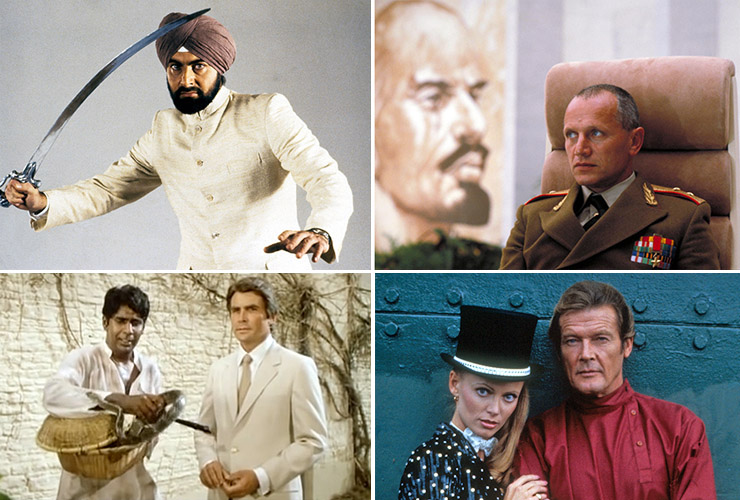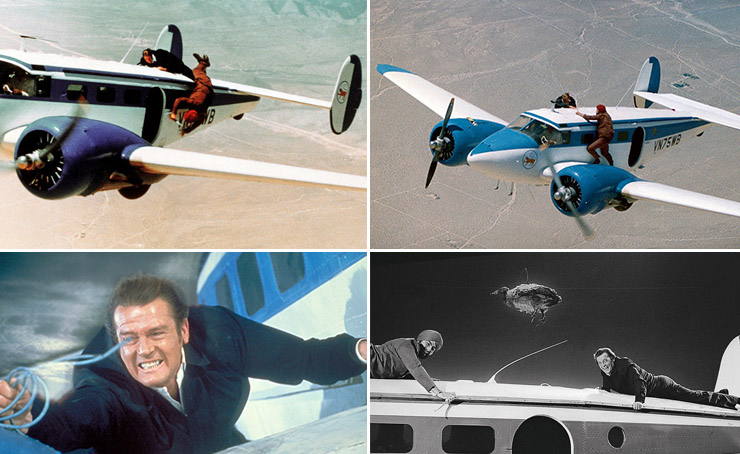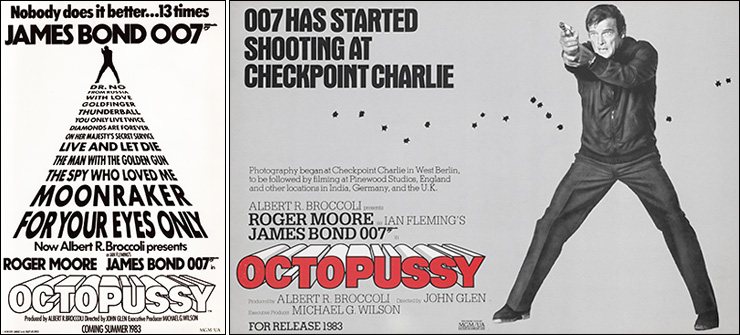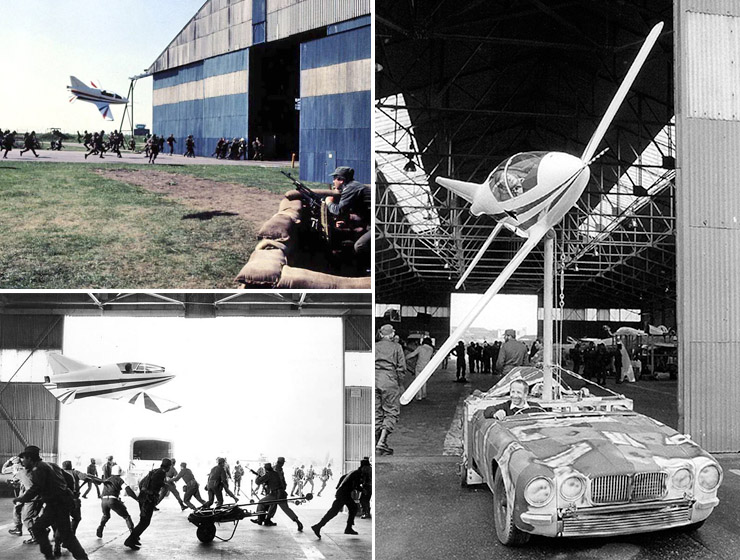 |
|
After his initial
three-film contract had expired after The Spy Who Loved Me (1977),
Roger Moore then signed on to play James Bond on a film-by-film basis,
although at the time Octopussy was being developed he had not
agreed to return, and the producers were testing other potential actors
for the starring role. In early June 1982 British actors Oliver Tobias and
Michael Billington took part in screen tests at Pinewood Studios, and on
June 22nd and 23rd American actor James Brolin was also tested. Playing
opposite him as Tatiana Romanova in the obligatory From Russia With
Love Venice hotel bedroom scene, was Maud Adams – who had played the
ill-fated Andrea Anders in The Man With The Golden Gun opposite
Roger Moore and Christopher Lee in 1974. Although Brolin’s test was
received positively by the filmmakers, producer ‘Cubby’ Broccoli still
felt that Bond should be played by a British actor, he ultimately struck a
deal with Roger Moore in mid-July 1982 to return to the role of Bond for
what the actor believed would be the final time. Joining him on Octopussy
would be Maud Adams in the title role following her test with James Brolin. |
 |
|
ABOVE: An
international supporting cast (top left) Indian star Kabir Bedi as
Gobinda. (top right) British theatre actor, author and playwright
Steven Berkoff was cast in the key role of General Orlov, with
international tennis star Vijay Amritraj playing Bond’s MI6
contact in India. Amritraj (bottom left) had tested for the role
[with a very reluctant snake!] alongside American actor James
Brolin as a prospective new James Bond in June 1982. (bottom
right) Swedish actress Kristina Wayborn signed on to play
Octopussy’s second-in-command Magda. |
|
|
|
For the role of the now villainous Kamal Khan, French-born former
Hollywood heartthrob Louis Jourdan was cast as the exiled Afghan Prince,
after originally being considered for the role of Sir Hugo Drax in
Moonraker (1979). Larger-than-life theatre actor, author and
playwright Steven Berkoff was cast in the key role of General Orlov, with
international tennis star Vijay Amritraj playing Bond’s MI6 contact in
India. ‘Cubby’ Broccoli was a huge tennis fan, and having seen Amritraj
play at Wimbledon had him screen tested alongside James Brolin at Pinewood
Studios in June 1982. Swedish actress Kristina Wayborn signed on to play
Octopussy’s second-in-command Magda, with established Indian actor Kabir
Bedi playing Kamal Khan’s bodyguard Gobinda. Other small roles in the film
were filled by Douglas Wilmer as antiques expert Jim Fanning,
and Sri-Lankan
born actor Albert Moses as Sadruddin –the head of the MI6 station in
India, having previously played a waiter in The Spy Who Loved Me
(1977). Making his debut as M was
Robert Brown, who was joined by Lois
Maxwell, Desmond Llewelyn, Geoffrey Keen and Walter Gotell – all reprising
their respective roles in the series. Also reprising his role as Smithers,
an MI6 operative and assistant to Q, was
Jeremy Bulloch. Returning to play
General Gogol's assistant Rublevitch for a third time, was Austrian-born
actress and Miss World 1969, Eva Rueber-Staier. |
 |
|
ABOVE: (top left & Right) The climax of Octopussy was
one of the first sequences filmed in June 1982. Returning to the
series were American stuntmen Jake Lombard and B.J. Worth, who
doubled for Roger Moore and Kabir Bedi. (bottom left) The
two actors later completed the scenes at Pinewood Studios, with
close-ups and insert shots filmed against a rear-projection
process screen. (bottom right) The crew found time to keep the actors entertained
between takes by suspending a stuffed duck above them as the fight
on the mock-up of Kamal Khan's twin-engined Beechcraft Model 18
plane. |
|
|
|
Filming began on June 6,
1982 in Utah with the aerial unit capturing the footage of Bond and
Gobinda fighting on the exterior of Kamal Khan’s twin-engined plane as he
escapes at the climax of the film. Returning to the series were American
stuntmen Jake Lombard and B.J. Worth, who doubled for Roger Moore
(although still not confirmed as playing James Bond) and Kabir Bedi. The
team had previously performed the aerial stunt work seen in the pre-credit
sequence of Moonraker (1979), overseen by second unit director
John
Glen. Failing to capture footage of a remote-controlled plane crashing and
exploding, the sequence was later completed with a scale model at Pinewood
Studios by special effects supervisor John Richardson. Principal
photography began on Monday August 9th with Roger Moore and Robert Brown
filming scenes at the famous Checkpoint Charlie in West Berlin. The start
of filming on Octopussy was announced in trade magazines with a
double-page advertisement showing a still of Roger Moore in his iconic
firing stance from For Your Eyes Only (1981). The first unit
returned briefly to Pinewood Studios in mid-August to film the scenes in
M’s office and Sotheby’s auction. Also filmed were the scenes with Miss
Moneypenny and her new assistant Penelope Smallbone played by
Michaela Clavell; daughter of the best-selling novelist, screenwriter, and film
director James Clavell (1921-1994). The filmmakers considered making Miss
Smallbone a recurring character who would take over when
Lois Maxwell left
her role, but this idea was never followed up, and Moneypenny was simply
recast as new actors took on the role of James Bond. |
 |
|
In late August the first
and second units travelled to the RAF base at Upper Heyford in Oxfordshire
to capture the scenes for the film’s climax in Octopussy’s Big Top Circus
tent. The RAF base was doubling for the West German Army base specified in
the script. After three days filming the production then moved to RAF
Northolt in Ruislip, Middlesex to gather the material required for the
spectacular pre-credit sequence. Once again the British RAF base was
doubling for a South American location as Bond goes in disguise as an Army
General. Despite the addition of palm trees and extras in skimpy outfits,
the finished result still looks like a cold UK location. In the first week
of September 1982, the climax of the sequence involving Bond’s escape from
a heat-seeking missile was filmed with a full-size version of 007’s
Acrostar Jet mounted on a Jaguar car driven by special effects maestro
John Richardson. Originally intended to be used in Moonraker
(1979), the Bede Jet was supposed to have been flown through a hangar at
the airbase by pilot John W. ‘Corkey’ Fornof; but in the finished film
this was achieved with a combination of foreground miniatures, the
full-scale Jaguar-mounted version, and a scale model of the exploding
hangar that was destroyed back at Pinewood Studios on January 13, 1983. |
 |
|
ABOVE: The spectacular pre-credit sequence showing Bond’s
escape from a heat-seeking missile was filmed with pilot John W.
‘Corkey’ Fornof, matched with a full-size version of 007’s
Acrostar Jet mounted on a Jaguar car driven by special effects
maestro John Richardson (above right). The entry of the plane into
the hangar was was achieved with a combination of foreground
miniatures, with a scale model
of the building
destroyed by explosions completed at Pinewood Studios. |
|
|
|
With the announcement
that a rival Bond production had started filming in the South of France in
late September 1982, the Octopussy unit then moved to India for the
bulk of the location filming. The unit encountered numerous crowd control
problems in Udaipur, when onlookers simply walked into shot as
stunt-driving supervisor
Remy Julienne and his team were trying to safely
capture the shots required for the taxi-chase sequence. Whilst the first
unit progressed in India, the second unit supervised by
Arthur Wooster was
back in the UK shooting the train sequences on the Nene Valley Railway
near Peterborough. Two weeks after beginning work at the location,
experienced stuntman, and Roger Moore double
Martin Grace (1942-2010) was
involved in a serious accident on September 28, 1982 which almost cost him
his life. The sequence where Bond climbs outside the moving train to move
to the next carriage had been carefully inspected ahead of the filming,
but the train continued beyond the designated safe stopping point and
Martin Grace hit a concrete post at the side of the track, and although
seriously injured clung onto the train until he could be transported to
hospital where it was discovered he had broken his pelvis and thigh bones.
Whilst recovering in Peterborough hospital he was visited on several
occasions by Roger Moore, following his return from India. |
 |
|
Whilst in India, the
first unit also captured the tiger hunt sequence, inspired in part by the
1924 short story The Most Dangerous Game by American author Richard
Connell (filmed under the same title in 1932 by King Kong director
Ernest B. Schoedsack – with Irving Pichel). The climax of the sequence saw
James Bond (Roger Moore) escape his pursuers, after encountering every
jungle-based cliché ever filmed, before being rescued by a group of
American tourists on a river trip which gave co-producer
Michael G. Wilson
(and his wife Jane) the opportunity to make his cameo appearance in the
film. The sequence is indicative of the way the James Bond films were then
moving; a relatively serious sequence is marred by the inclusion of
juvenile jokes and Tarzan calls, and highlights the fact that the
filmmakers didn’t know in which direction they wanted the storyline to
develop. The contemporary Cold-War backstory is played more or less
straight; whereas other sequences are littered with ‘in-jokes’ – from
Vijay Amritraj playing ‘The James Bond Theme’ as he charms a snake by way
of introduction, to a laughable climax involving Q (Desmond Llewelyn) in a
hot-air balloon as he attempts to rescue 007. For much of its running time
Octopussy (1983) is a film at odds with itself. |
 |
|
CONTINUED |
|



